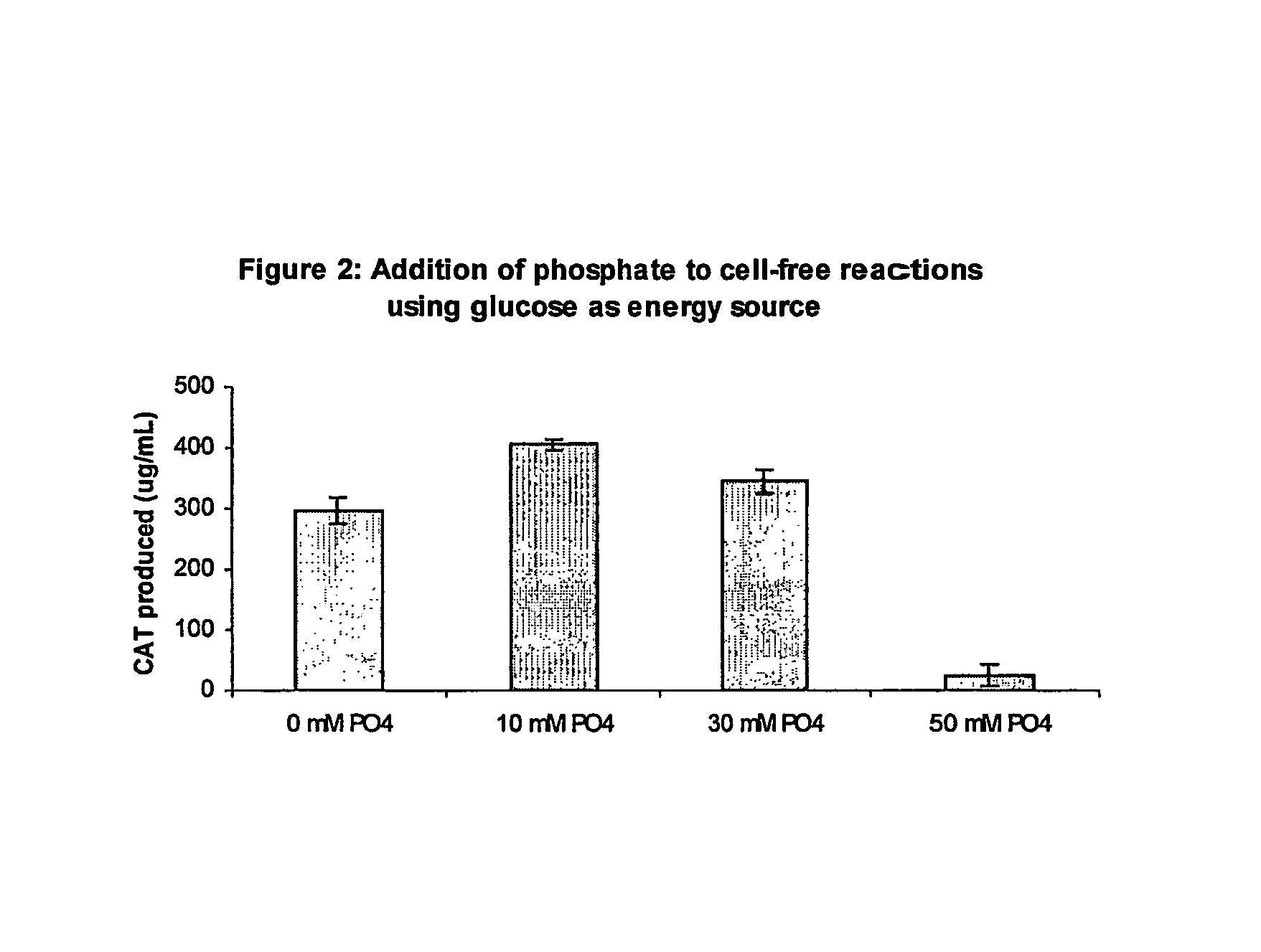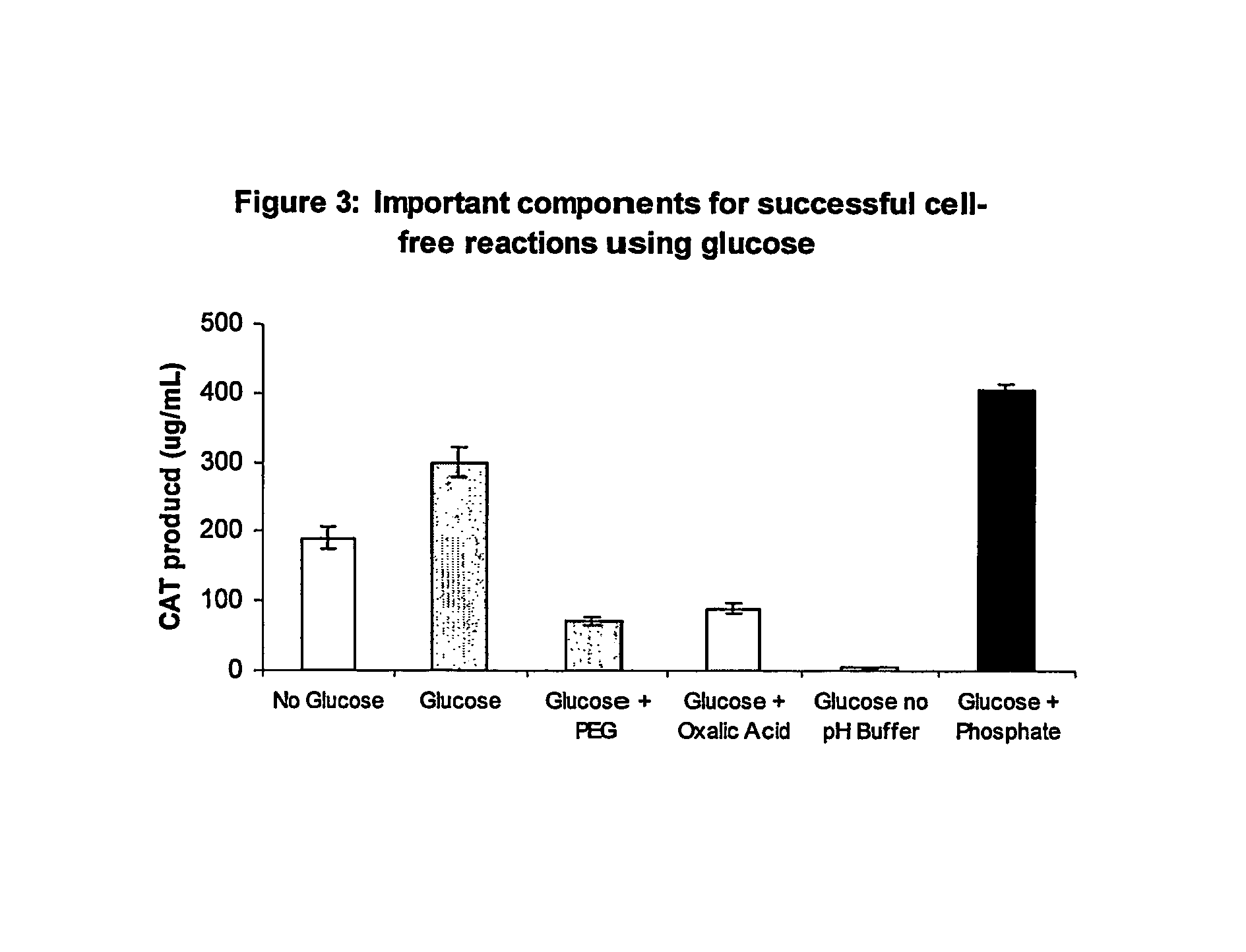Methods of in vitro protein synthesis
a protein synthesis and in vitro technology, applied in the field of in vitro protein synthesis, can solve the problems of poor protein synthesis yield, excessive reagent cost, limited practical use and large-scale implementation, etc., and achieve the effects of enhancing utility, reducing costs, and improving yield
- Summary
- Abstract
- Description
- Claims
- Application Information
AI Technical Summary
Benefits of technology
Problems solved by technology
Method used
Image
Examples
example 1
Glucose as an Energy Source
Methods and Materials
[0054]The standard Cytomim environment for synthesis, contains the following components: 1.2 mM ATP, 0.85 mM each of GTP, UTP and CTP, 1 mM DTT, 130 mM potassium glutamate, 10 mM ammonium glutamate, 8 mM magnesium glutamate, 34 μg / ml folinic acid, 170.6 μg / ml E. coli, tRNA mixture, 13.3 μg / ml plasmid, 100 μg / ml T7 RNA polymerase, 2 mM each of 20 unlabeled amino acids, 11 μM [14C]leucine, 1.5 mM spermidine and 1 mM putrescine, 0.33 mM nicotinamide adenine dinucleotide, 0.26 mM Coenzyme A, 2.7 mM sodium oxalate and 0.24 volumes of S30 extract. Prokaryotic cell-free protein synthesis is performed using a crude S30 extract derived from Escherichla coli K12 (strain KC1 described in Michel-Reydellet et al (2004) Met Eng (6)197-203, genotype A19 ΔtonA ΔtnaA ΔspeA ΔendA ΔsdaA ΔsdaB met+), with slight modifications from the protocol of Pratt, J. M. 1984. (Coupled transcription-translation in prokaryotic cell-free systems. In Transcription and t...
example 2
Glutamate as an Energy Source
[0068]The reaction mixture for combined transcription-translation reactions described below contains the following components: 1.2 mM ATP, 0.85 mM each of GTP, UTP and CTP, 130 mM potassium glutamate, 10 mM ammonium glutamate, 10 mM magnesium glutamate, 1.5 mM spermidine, 1 mM putrescine, 34 μg / ml folinic acid, 170.6 μg / ml E. coli, tRNA mixture, 13.3 μg / ml plasmid, 100 μg / ml T7 RNA polymerase, 2 mM each of 20 unlabeled amino acids, 5 μM L-[U-14C]-leucine, 0.33 mM nicotinamide adenine dinucleotide, 0.26 mM Coenzyme A, 4.0 mM sodium oxalate and 0.24 volumes of S30 extract.
[0069]Pyruvate was omitted as an energy source. In this situation, supplementation with 10 mM potassium phosphate, pH 7.2 (with glacial acetic acid), is beneficial for protein expression. In addition to using NTPs (ATP, GTP, UTP, and CTP), reactions can also be performed with NMPs (AMP, GMP, UTP, and CMP) at the same stating concentrations as described above. There is approximately 3.3 mM...
PUM
| Property | Measurement | Unit |
|---|---|---|
| pH | aaaaa | aaaaa |
| pKa | aaaaa | aaaaa |
| volume | aaaaa | aaaaa |
Abstract
Description
Claims
Application Information
 Login to View More
Login to View More - R&D
- Intellectual Property
- Life Sciences
- Materials
- Tech Scout
- Unparalleled Data Quality
- Higher Quality Content
- 60% Fewer Hallucinations
Browse by: Latest US Patents, China's latest patents, Technical Efficacy Thesaurus, Application Domain, Technology Topic, Popular Technical Reports.
© 2025 PatSnap. All rights reserved.Legal|Privacy policy|Modern Slavery Act Transparency Statement|Sitemap|About US| Contact US: help@patsnap.com



